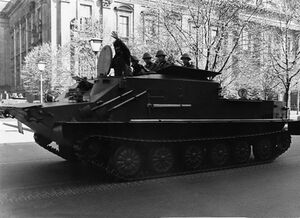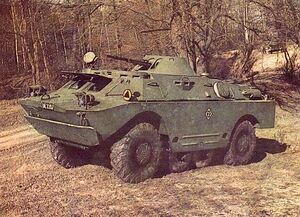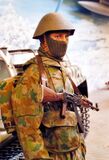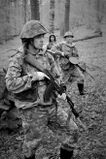Calinthian People's Army: Difference between revisions
mNo edit summary |
mNo edit summary |
||
| Line 145: | Line 145: | ||
|Amphibious Assault Vehicles | |Amphibious Assault Vehicles | ||
|6,112 | |6,112 | ||
|736 in storage (mostly Joraine MK II) | |736 in storage (mostly Joraine MK II taken from the Calinthian Armed Forces following 1961) | ||
|} | |} | ||
[[File:BM-62 Side.jpg|thumb|BM-62 at a training camp in Spesnova (1973)]] | [[File:BM-62 Side.jpg|thumb|BM-62 at a training camp in Spesnova (1973)]] | ||
Revision as of 19:24, 15 December 2023
| Calinthian People's Army Gothic: Kalinthische Volksarmee | |
|---|---|
| Motto | Für Gott und die Einheit der Arbeiter (For God and Unity of the Workers) |
| Founded | Founded in 1942. |
| Current form | Military Besserung of 1944 |
| Headquarters | Spesnova, Calinthia |
| Leadership | |
| Grand General | Siegmund Goering |
| Minister of Defense | General of the Military Friedrich von Guder |
| Manpower | |
| Military age | 18 |
| Conscription | Yes, mandatory for males and females. |
| Active personnel | 1,263,138 military & 219,114 civilian (1978) |
| Reserve personnel | At any time, 2,000,000 reservists could be called upon |
| Industry | |
| Domestic suppliers | Bralonia • |
| Foreign suppliers | |
| Related articles | |
| History | Military history of Calinthia |
| Ranks | Ranks and insignia of the Calinthian People's Army |
The Calinthian People's Army (KVA) is the military of the People's Republic of Calinthia. Gothic: "Volksrepublik Kalinthische"
History
The history of the Calinthian People's Army dates back to the creation of the People's Republic of Calinthia (PRC) in 1942. The Calinthian People's Army was raised to defend the goals of the Calinthian Communist Party in establishing a Soviet State during the Calinthian Civil War. The Calinthian Civil War would rage for six years and would see the KVA fight against Republican Guard Forces and Loyalist Forces.
The Communist uprisings on the Western territories of Calinthia by mainly Gothic Calinthians resulted in Republican Guard Forces being stretched thin. At first the Communist Calinthians and Loyalist Calinthians would openly fight one another in many minor skirmishes in the North. However, by late 1937 the Communist Calinthians under General Secretary of the Communist Party Siegmund Goering (1901 - 1991) would ally themselves with the Loyalists against the Republican Guard Forces. With Communist forces in the West and Loyalists in the East, the Republican Guard quickly found themselves on the back-foot. By early 1940, Republican Guard Forces prepared a hastily built defense around Aurelia and struggled to maintain their supply lines from the port of Napolis. Constant air attacks by the superior Loyalist air force rendered many of the railroads inoperable. In addition, Communist forces under the command of Karl Vorkas would launch guerilla warfare assaults on Republican garrisons stealing millions worth of military equipment. By the end of the Calinthian Civil War in 1942, the Communist forces would create the Calinthian People's Army (KVA) using the equipment they had stolen from the Republic of Calinthia as well as the equipment donated to them from the foreign supplier Yonderre.


The Calinthian Civil War resulted in the dissolution of the Republic of Calinthia and it's military in 1942. Following the collapse of the Republic of Calinthia, Gothic Calinthians formalized their new state through the creation of the Communist State of Calinthia. In 1944, the Calinthian People's Army would undergo reformations to strengthen the military might of the PRC. These reformations were the Military Besserung of 1944.
Command structure
Organization
Tactics & Strategy
Since the Military Besserung of 1944, KVA ground tactics consists of large mechanized and armoured assaults with supporting artillery using the Calinthian strategy of 'Manöververteidigung' (maneuver defense). In Maneuver Defense, Calinthian forces dig entrenched forward positions in such a way that they can easily fall back while under the cover of other nearby friendly positions. When the KVA go on the offensive, they do so slowly and methodically, building entrenchments, forward operating bases, and solidifying logistical lines. In addition, a strong reliance on tanks, mobile infantry, as well as mass artillery mean that no unit has a high likelihood of being unsupported at any given time. However, in exchange for survivability and time, KVA forces relinquish land and even fortified positions. This means most KVA units choose to retreat to better positions rather than stay and fight to the death. However, some generals will give or be given the order to hold their positions in a static defense such as at the Battle of Wagner Platz. Most Calinthian equipment represents this strategy and preference of long range engagements. KVA general Hannelore von Klaive was the first to formalize the concept of maneuver defense against loyalists in the Calinthian Civil War.
Equipment
All numbers are approximate and as per the Calinthian People's Army own statistics from the People's Republic of Calinthia report of 2001.
| Equipment | Numbers | Notes |
|---|---|---|
| Main Battle Tanks | 6,121 | |
| APCs/IFVs/Scout Cars | 11,613 | Mostly BM-52s, BM-62s, and BT-51s. |
| Utility Vehicles | 3,111 | |
| Trucks | 612 | |
| Towed Artillery | 14,689 | |
| MLRS | 912 | |
| Fighter Aircraft | 114 | Land deployment only |
| Bomber Aircraft | 346 | Land deployment only |
| Transport Helicopters | 189 | Most are AMS-68 imported from Yonderre |
| Attack Helicopters | 123 | Most are AMS-72 imported from Yonderre |
| Amphibious Assault Vehicles | 4,896 | Mostly BT-51s, and BT-62s |
Naval Equipment:
| Destroyers | 31 | 26 in storage, with 11 more in production |
| Carriers | 12 | 4 in production |
| Submarines | 61 | 12 in storage |
| Hospital and Logistical ships | 200 | 23 in storage |
| Cruisers | 121 | 11 in storage |
| Amphibious Assault Vehicles | 6,112 | 736 in storage (mostly Joraine MK II taken from the Calinthian Armed Forces following 1961) |

Gallery
-
KVA Blumentarn camo uniform and wool Kopfschützer in Spesnova National Heritage Museum
-
BT-56 equipped with a BSG-3
-
KVA soldiers advancing on Loyalist positions around Karlsplatz (1956)
Notes
Calinthian People's Army had direct control over the Air Force wing of the Calinthian People's Military.


